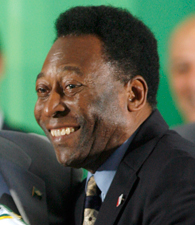Pelé turned a childhood of playing soccer in a small Brazilian village into athletic stardom. Known as “The King of Football,” he spent his career breaking records and defying expectations.
Pelé’s Early Days
Born October 23, 1940, in Três Corações, Brazil, to Dondinho, a semiprofessional soccer player and Maria Celeste Arantes, Pelé’s given name was Edson Arantes do Nascimento, but they called him “Dico” for short.
Despite his mother’s protestations—her husband had not made a good living from soccer—as soon as he was able, Pelé began to kick a soccer ball. He was a quick study and developed a keen passion for the game, which was the most popular sport in his country. In 1950, after Brazil’s loss in the World Cup Finals, Pelé consoled his crying father, saying, “Don’t worry. One day I’ll win it.”
That day came sooner than anyone would have thought: at 11, Pelé was spotted by Waldemar de Brito, a top Brazilian soccer player. When he was 14, he joined the juniors of a local club team and at 16 he joined the team he would play with for the next 18 years.
Sources in this Story
- Biography.com: Pele Biography (1940–)
- FIFA: Pele Biography
- International Football Hall of Fame: Pele
- The Time 100: Pelé
- UNESCO: Edson Arantes Do Nascimento Pelé
- ESPN FC: Brazil football legend Pele honoured with Olympic Order
- Latino Sports Legends: Pelé: Birth of a Legend [Movie Info & Trailer]
Pelé’s Notable Accomplishments
Brazil recruited Pelé for the national soccer team in 1957. During the 1958 FIFA World Cup in Sweden, Pelé earned a starting position in a match against the Soviet Union. Later, in the quarterfinals, he scored the team’s only goal against Wales, which established him as the youngest scorer in World Cup history. He followed that performance with a hat trick, scoring three goals in 23 minutes against France, and to the world’s astonishment, scored two goals against Sweden in the Finals, earning his team their first-ever World Cup.
His freshman performance garnered him the Cup’s second-highest honor, the Silver Ball, and he was carried off the field by his exuberant teammates. “I felt like I was living in a dream,” recalled Pelé of that moment.
Although he returned to Santos, his home club team, Pelé had become an international star. He lived up to the buzz surrounding his abilities. In the year after his first World Cup, he scored 127 goals, 58 of which occurred during the state championship; this established him as the top scorer, a title he would hold for nine years straight.
During the next two years, Pelé led Santos to numerous successes; he scored 110 goals in 1961 and led the team to countrywide and South American victory. 1962 brought another World Cup and, naturally, Pelé played for the Brazil team. During their second game against Czechoslovakia, Pelé injured his groin, leaving him benched for the rest of the series. The team won their second Cup, and Pelé spent the next three years scoring against his local rivals and preparing for his next World Cup.
In England in 1966, Pelé was prepared to put up a fight. But so were his opponents, who focused their violence on Brazil’s star player. Pelé was carried out on a stretcher after players from Bulgaria and Portugal directed the majority of their tackles in his direction. Brazil failed to win the Cup in those games, but in 1970, the team rebounded in the first televised World Cup. Pelé scored one of the team’s winning goals over Italy and Brazil walked away with its third Cup, the only team at that point to hold that honor.
The Man and his Work
After 18 years of playing—an unheard-of number in a time when soccer players lasted a decade, tops—Pelé announced his retirement in 1974. But the next year, he joined the New York Cosmos, signing a highly lucrative contract (reports vary as to how much; somewhere between $3.5 and $7 million) for a three-year stint. He is credited with popularizing the sport in the United States and he led the team to the North American Soccer League championship before he retired from soccer altogether in 1977. In his time playing the sport, he scored more than 1,200 goals, an astonishing figure that has very rarely been surpassed.
The Rest of the Story
In addition to his popularity as an athletic star, Pelé has served as something of an honorary statesman. The United Nations Educational, Scientific and Cultural Organization, known as UNESCO, named Pelé as a UNESCO Champion for Sport in 1994. UNESCO described his work with a Children in Need telethon and gala, and participating in The Match of the Heart 2000, which was held to support the Israeli-Palestinian peace process.
The International Olympic Committee named Pelé Athlete of the Century in 1999, even though he never played in any Olympic games, and he was voted Footballer of the Century by FIFA. His post-soccer career has included product placements and merchandising as well as movie appearances.
In 2016, a film about Pele’s life called “Pelé: Birth of a Legend” was released. According to Latino Sports, the movie was shot entirely on location in Brazil.
This article was originally written by Jennifer Ferris; it was updated October 24, 2017.











